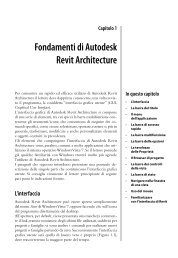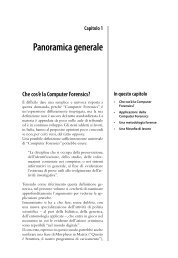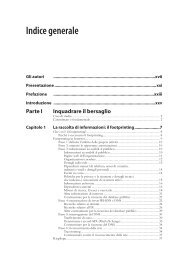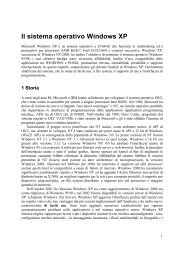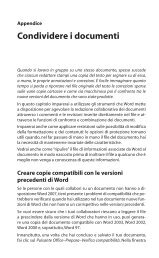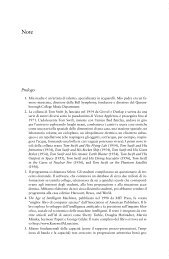Esercizi e progetti di programmazione - Apogeo
Esercizi e progetti di programmazione - Apogeo
Esercizi e progetti di programmazione - Apogeo
Create successful ePaper yourself
Turn your PDF publications into a flip-book with our unique Google optimized e-Paper software.
ESERCIZI E PROGETTI DI PROGRAMMAZIONE E–23<br />
bisestile se è <strong>di</strong>visibile per 400 (per esempio, il 2000). Scrivete un programma che chieda all’utente<br />
<strong>di</strong> inserire un anno e che calcoli se è bisestile. Scrivere una classe Year con un metodo pre<strong>di</strong>cativo<br />
boolean isLeapYear().<br />
* <strong>Esercizi</strong>o P5.13. Scrivete un programma che chieda all’utente <strong>di</strong> inserire il numero corrispondente<br />
a un mese (1 per gennaio, 2 per febbraio, e così via), e che quin<strong>di</strong> stampi il numero <strong>di</strong> giorni del<br />
mese. Nel caso <strong>di</strong> febbraio, stampate comunque “28 days”.<br />
Enter a month(1-12):<br />
5<br />
31 days<br />
Realizzate una classe Month con un metodo int getDays(). Non usate un <strong>di</strong>verso enunciato if<br />
o else per ogni mese, ma fate uso <strong>di</strong> operatori booleani.<br />
*** <strong>Esercizi</strong>o P5.14. Scrivete un programma che legga due numeri in virgola mobile, per poi <strong>di</strong>chiararli<br />
uguali se, quando vengono arrotondati con due cifre decimali dopo la virgola, <strong>di</strong>fferiscono<br />
per meno <strong>di</strong> 0.01. Ecco due esempi <strong>di</strong> esecuzione:<br />
Enter two fl oating-point numbers:<br />
2.0<br />
1.99998<br />
They are the same when rounded to two decimal places.<br />
They <strong>di</strong>ffer by less than 0.01.<br />
Enter two fl oating-point numbers:<br />
0.999<br />
0.991<br />
They are <strong>di</strong>fferent when rounded to two decimal places.<br />
They don’t <strong>di</strong>ffer by less than 0.01.<br />
* <strong>Esercizi</strong>o P5.15. Migliorate la classe BankAccount del Capitolo 3, in modo da:<br />
1. Rifi utare importi negativi nei meto<strong>di</strong> deposit e withdraw.<br />
2. Rifi utare prelievi che portino a un saldo negativo.<br />
* <strong>Esercizi</strong>o P5.16. Scrivete un programma che riceva la retribuzione oraria <strong>di</strong> un <strong>di</strong>pendente.<br />
Quin<strong>di</strong>, chiedete quante ore ha lavorato il <strong>di</strong>pendente la scorsa settimana. Assicuratevi <strong>di</strong> accettare<br />
le frazioni <strong>di</strong> ora e calcolate la retribuzione. Eventuali straor<strong>di</strong>nari (oltre le 40 ore settimanali) vanno<br />
pagati nella misura del 150 per cento rispetto alla retribuzione normale. Risolvete il problema<br />
scrivendo una classe Paycheck.<br />
** <strong>Esercizi</strong>o P5.17. Scrivete un programma per la conversione <strong>di</strong> unità <strong>di</strong> misura. Chiedete all’utente<br />
da quale unità vuole convertire e qual è l’unità <strong>di</strong> destinazione (in per pollice, ft per piede, mi per<br />
miglio, mm per millimetro, cm per centimetro, m per metro e km per chilometro). Usate due oggetti<br />
<strong>di</strong> una classe UnitConverter, uno che converta in metri e uno che converta da metri.<br />
Convert from:<br />
in<br />
Convert to:<br />
mm<br />
Value:<br />
10<br />
10 in = 254 mm<br />
*** <strong>Esercizi</strong>o P5.18. Una retta giacente in un piano può essere specifi cata in <strong>di</strong>versi mo<strong>di</strong>:<br />
me<strong>di</strong>ante un punto (x, y) e una pendenza m<br />
Cay Horstmann: Concetti <strong>di</strong> informatica e fondamenti <strong>di</strong> Java 5 a ed. - Copyright 2010 <strong>Apogeo</strong> srl




